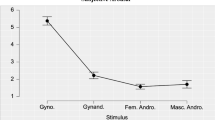Abstract
An individual’s reproductive potential appears to influence response to attractive faces of the opposite sex. Otherwise, relatively little is known about the characteristics of the adult observer that may influence his or her affective evaluation of male and female faces. An untested hypothesis (based on the proposed role of attractive faces in mate selection) is that most women would show greater interest in male faces whereas most men would show greater interest in female faces. Further, evidence from individuals with preferences for same-sex sexual partners suggests that response to attractive male and female faces may be influenced by gender-linked play preferences. To test these hypotheses, visual attention directed to sex-linked stimuli (faces, toys, play styles) was measured in 39 men and 44 women using eye tracking technology. Consistent with our predictions, men directed greater visual attention to all male-typical stimuli and visual attention to male and female faces was associated with visual attention to gender conforming or nonconforming stimuli in a manner consistent with previous research on sexual orientation. In contrast, women showed a visual preference for female-typical toys, but no visual preference for male faces or female-typical play styles. These findings indicate that sex differences in visual processing extend beyond stimuli associated with adult sexual behavior. We speculate that sex differences in visual processing are a component of the expression of gender phenotypes across the lifespan that may reflect sex differences in the motivational properties of gender-linked stimuli.
Similar content being viewed by others
Notes
The stimuli are available from the corresponding author upon request.
References
Alexander, G. M. (2003). An evolutionary perspective of sex-typed toy preferences: Pink, blue, and the brain. Archives of Sexual Behavior, 32, 7–14.
Alexander, G. M., & Hines, M. (1994). Gender labels and play styles: Their relative contribution to children’s selection of playmates. Child Development, 65, 869–879.
Alexander, G. M., & Hines, M. (2002). Sex differences in responses to children’s toys in a non-human primate (cercopithecus aethiops sabaeus). Evolution and Human Behavior, 23, 467–479.
Alexander, G. M., Wilcox, T., & Woods, R. (in press). Sex differences in infants’ visual interest in toys. Archives of Sexual Behavior.
Bailey, J. M., & Zucker, K. J. (1995). Childhood sex-typed behavior and sexual orientation: A conceptual analysis and quantitative review. Developmental Psychology, 31, 43–55.
Berenbaum, S. A., & Hines, M. (1992). Early androgens are related to childhood sex-typed toy preferences. Psychological Science, 3, 203–206.
Berridge, K. C., & Robinson, T. E. (2003). Parsing reward. Trends in Neurosciences, 26, 507–513.
Blakemore, S.-J., & Frith, U. (2004). How does the brain deal with the social world? NeuroReport, 15, 119–128.
Bussey, K., & Bandura, A. (1999). Social-cognitive theory of gender development and differentiation. Psychological Review, 106, 676–713.
Campbell, A., Shirley, L., & Heywood, C. (2000). Infants’ visual preference for sex-congruent babies, children, toys and activities: A longitudinal study. British Journal of Developmental Psychology, 18, 479–498.
Chivers, M. L., Rieger, G., Latty, E., & Bailey, J. M. (2004). A sex difference in the specificity of sexual arousal. Psychological Science, 15, 736–744.
Cloutier, J., Heatherton, T. F., Whalen, P. J., & Kelley, W. M. (2008). Are attractive people rewarding? Sex differences in the neural substrates of facial attractiveness. Journal of Cognitive Neuroscience, 20, 941–951.
Cohen, J. (1977). Statistical analysis for the behavioral sciences. New York: Academic Press.
Connellan, J., Baron-Cohen, S., Wheelwright, S., Batki, A., & Ahluwalia, J. (2000). Sex differences in human neonatal social perception. Infant Behavior and Development, 23, 113–118.
Drummond, K. D., Bradley, S. J., Peterson-Badali, M., & Zucker, K. J. (2008). A follow-up study of girls with gender identity disorder. Developmental Psychology, 44, 34–45.
Dunne, M. P., Bailey, J. M., Kirk, K. M., & Martin, N. G. (2000). The subtlety of sex-atypicality. Archives of Sexual Behavior, 29, 549–565.
Fink, B., & Penton-Voak, I. S. (2002). Evolutionary psychology of facial attractiveness. Current Directions in Psychological Science, 11, 154–158.
Geary, D. C. (1999). Male, female: The evolution of human sex differences. Washington DC: American Psychological Association.
Hassett, J. M., Siebert, E. R., & Wallen, K. (2008). Sex differences in rhesus monkey toy preferences parallel those of children. Hormones and Behavior, 54, 359–364.
Hines, M., Brook, C., & Conway, G. S. (2004). Androgen and psychosexual development: Core gender identity, sexual orientation, and recalled childhood gender role behavior in women and men with congenital adrenal hyperplasia (CAH). Journal of Sex Research, 41, 75–81.
Honekopp, J. (2006). Once more: Is beauty in the eye of the beholder? Relative contributions of private and shared taste to judgments of facial attractiveness. Journal of Experimental Psychology: Human Perception and Performance, 32, 199–209.
Jones, B. C., DeBruine, L. M., Perrett, D. I., Little, A. C., Feinberg, D. R., & Law Smith, M. J. (2008). Effects of menstrual cycle phase on face preferences. Archives of Sexual Behavior, 37, 78–84.
Kranz, F., & Ishai, A. (2006). Face perception is modulated by sexual preference. Current Biology, 16, 63–68.
Lankford, C. (2000). Gazetracker: Software designed to facilitate eye movement analysis. New York: ACM Press.
Levy, B., Ariely, D., Mazar, N., Chi, W., Lukas, S., & Elman, I. (2008). Gender differences in the motivational processing of facial beauty. Learning and Motivation, 39, 136–145.
Lippa, R. A. (2005). Gender, nature, and nurture (2nd ed.). Mahwah, NJ: Erlbaum.
Lippa, R. A. (2006). Is high sex drive associated with increased sexual attraction to both sexes? Psychological Science, 17, 46–52.
Little, A. C., Burt, D. M., Penton-Voak, I. S., & Perrett, D. I. (2005). Self-perceived attractiveness influences human preferences for sexual dimorphism and symmetry in male faces. Proceedings of the Royal Society of London Series B, 268, 39–44.
Lykins, A. D., Meana, M., & Strauss, G. P. (2008). Sex differences in visual attention to erotic and non-erotic stimuli. Archives of Sexual Behavior, 37, 219–228.
Maccoby, E. E. (1988). Gender as a social category. Developmental Psychology, 24, 755–765.
Miller, G. F., & Todd, P. M. (1998). Mate choice turns cognitive. Trends in Cognitive Sciences, 2, 190–198.
Nisbett, R. E., & Wilson, T. D. (1977). Telling more than we can know: Verbal reports on mental processes. Psychological Review, 84, 231–259.
Nordenstrom, A., Servin, A., Bohlin, G., Larsson, A., & Wedell, A. (2002). Sex-typed toy play behavior correlates with the degree of prenatal androgen exposure assessed by cyp21 genotype in girls with congenital adrenal hyperplasia. Journal of Clinical Endocrinology and Metabolism, 87, 5119–5124.
Penton-Voak, I. S., Perrett, D. I., Castles, D. L., Kobaysahi, T., Burt, D. M., Murray, L. K., et al. (1999). Menstrual cycle alters face perception. Nature, 399, 741–742.
Quinn, P. D., Kelly, D. J., Lee, K., Pascalis, O., & Slater, A. M. (2008). Preference for attractive faces in human infants extends beyond conspecifics. Developmental Science, 11, 76–83.
Rayner, K. (1998). Eye-movements in reading and information processing: 20 years of research. Psychological Bulletin, 124, 372–422.
Rhodes, G. (2006). The evolutionary psychology of facial beauty. Annual Review of Psychology, 57, 199–226.
Richardson, D., & Spivey, M. (2000). Representation, space, and Hollywood squares: Looking at things that aren’t there anymore. Cognition, 76, 269–295.
Roney, J. R., Hanson, K. N., Durante, K. M., & Maestripieri, D. (2006). Reading men’s faces: Women’s mate attractiveness judgments track men’s testosterone and interest in infants. Proceedings of the Royal Society of London Series B, 273, 2169–2175.
Ruble, D. N., Martin, C. L., & Berenbaum, S. A. (2006). Gender development. In W. Damon & R. M. Lerner (Series Eds.), and N. Eisenberg (Vol. Ed.), Handbook of child psychology. Vol. 3: Social, emotional, and personality development (6th ed., pp. 858–932). New York: Wiley.
Rupp, H. A., & Wallen, K. (2007). Sex differences in viewing sexual stimuli: An eye-tracking study in men and women. Hormones and Behavior, 51, 524–533.
Silk, J. B., Alberts, S. C., & Altmann, J. (2003). Social bonds of female baboons enhance infant survival. Science, 302, 1231–1233.
Stanley, D., Phelps, E., & Banaji, M. (2008). The neural basis of implicit attitudes. Current Directions in Psychological Science, 17, 164–170.
Taylor, S. E., Cousino Klein, L., Lewis, B. P., Gruenewald, T. L., Gurung, R. A. R., & Updegraff, J. A. (2000). Biobehavioral responses to stress in females: Tend-and-befriend, not fight-or-flight. Psychological Review, 107, 411–429.
Welling, L. L. M., Jones, B. C., & DeBruine, L. M. (2008). Sex drive is positively associated with women’s preferences for sexual dimorphism in men’s and women’s faces. Personality and Individual Differences, 44, 161–170.
Zosuls, K. M., Ruble, D. N., Tamis-LeMonda, C. S., Shrout, P. E., Bornstein, M. H., & Greulich, F. K. (in press). The acquisition of gender labels in infancy: Implications for sex-typed play. Developmental Psychology.
Acknowledgements
The author thanks Julia Makkaoui and Jennifer Armstrong for help with behavioral testing. This research was supported by National Institute of Mental Health grant MH071414.
Author information
Authors and Affiliations
Corresponding author
Rights and permissions
About this article
Cite this article
Alexander, G.M., Charles, N. Sex Differences in Adults’ Relative Visual Interest in Female and Male Faces, Toys, and Play Styles. Arch Sex Behav 38, 434–441 (2009). https://doi.org/10.1007/s10508-008-9429-7
Received:
Revised:
Accepted:
Published:
Issue Date:
DOI: https://doi.org/10.1007/s10508-008-9429-7




